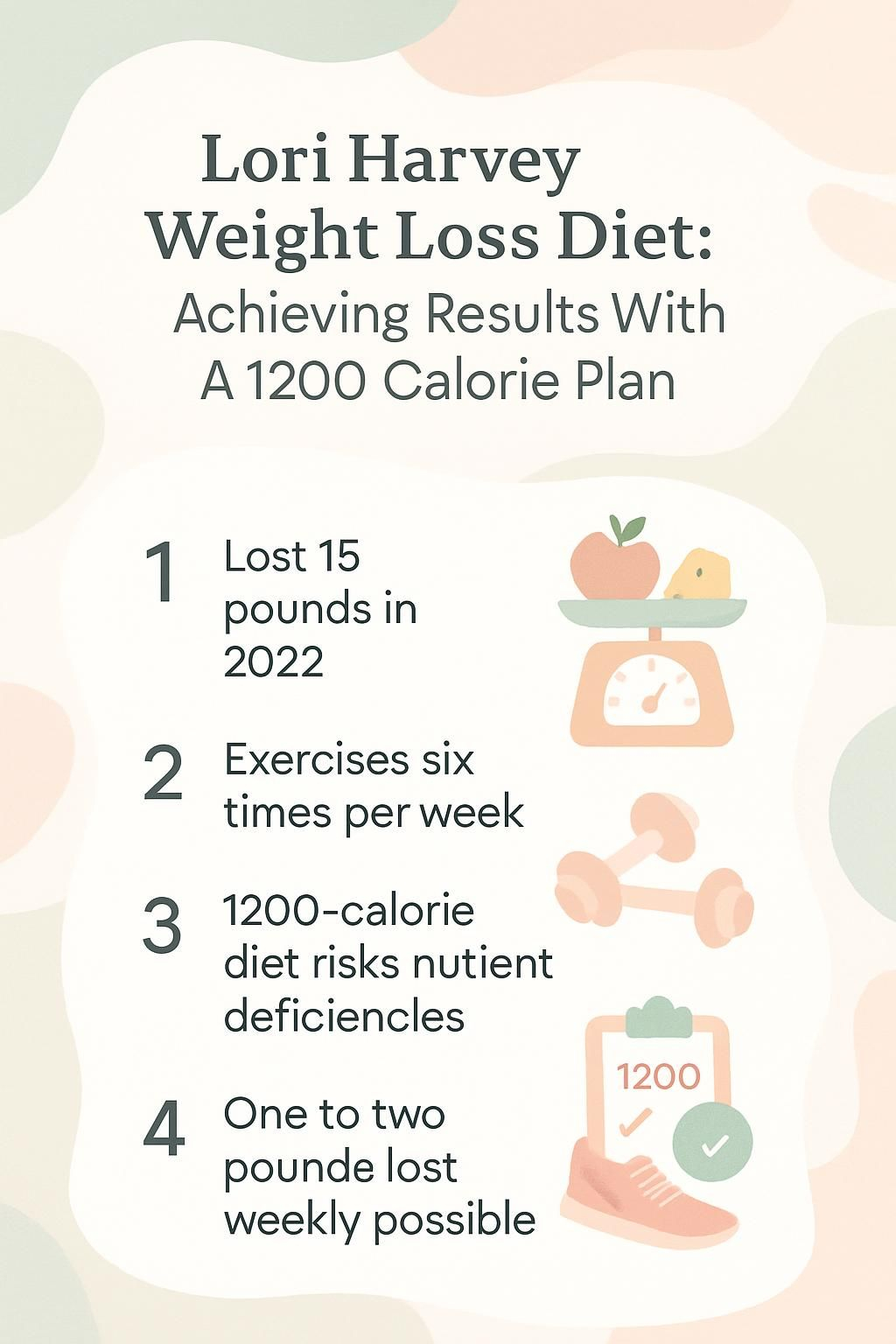Lori Harvey Weight Loss Diet: Achieving Results With A 1200 Calorie Plan
Our Nutrition Assistant AI Suite will transform your body. You will lose fat, get toned, and build muscle. Gain confidence and optimal health.
Looking for a simple, structured way to lose weight? The Lori Harvey Weight Loss Diet gained attention after she shared that she lost about 15 pounds in 2022 using a 1200 calorie plan and daily training. This guide explains how a steady calorie deficit, basic whole foods, and consistent workouts, including Pilates, can work together for safe progress.
You will see how she focused on protein, vegetables, and minimal carbs. You will also learn how to build a routine that fits your life with help from a nutritionist or trainer. Use these steps to plan smarter, protect your health, and stay consistent.
Key Takeaways
- Lori Harvey says she lost 15 pounds in 2022 using a strict 1200-calorie diet paired with near-daily workouts.
- Core foods were lean proteins, vegetables, and low-carb options, which helped control hunger and support muscle.
- Training included Pilates up to six times a week, plus cardio and strength work for tone and fat loss.
- Experts caution that 1200 calories can be low for many adults, so nutrient-dense foods and careful planning are essential.
- Most adults lose about 1 to 2 pounds per week with a steady calorie deficit and regular exercise, which matches public guidance.

Who is Lori Harvey and What Is Her Background?

Lori Harvey is a model and entrepreneur, known for her skincare brand and active lifestyle. She is the daughter of actor and host Steve Harvey.
Many people follow her weight loss journey on social media platforms like TikTok. She drew attention after explaining that she gained “like 15 pounds” of relationship weight while dating actor Michael B. Jordan, then worked to reach her Met Gala shape in 2022.
Her posts highlight regular Pilates sessions, a simple eating pattern built around protein and vegetables, and close attention to calories. Seeing a public figure commit to steady habits can make the process feel doable for you too.
How Did Lori Harvey Achieve Her Weight Loss?
Lori Harvey reported using a 1200-calorie diet to create a clear calorie deficit each day. Her meals centered on lean protein, plenty of vegetables, and lower-carb choices such as egg whites and oatmeal.
Training was consistent. She lifted weights with a personal trainer, added 30 minutes of cardio like treadmill work or stairs, and included sprint intervals to raise intensity. She also shared that she did Pilates often, which supported muscle tone and flexibility.
That combination helped her control calories while maintaining muscle. Small, steady steps produce reliable change.
That’s what worked best for my body — everyone is different so tailor your needs to meet your goals, Harvey said.
Next, see why protein, vegetables, and low carbs form the backbone of a 1200-calorie diet.
Key Elements of the 1200-Calorie Diet
This approach relies on basic whole foods, steady portions, and clear limits. Think of it as a simple template you can repeat.
Why Focus on Proteins, Vegetables, and Low Carbs?
Protein supports muscle maintenance while you lose weight. It also helps you feel full, which makes a low-calorie plan easier to follow. Vegetables add volume, fiber, and key vitamins and minerals for very few calories.
Lowering refined carbs reduces blood sugar swings and may limit hunger later in the day. Many people do well with lean meats, eggs, tofu, leafy greens, and low-sugar foods. This focus keeps nutrition high while calories stay controlled.
How Does Caloric Restriction Aid Weight Loss?
A calorie deficit means eating fewer calories than your body uses. Your body then taps stored fat for energy, which leads to weight loss. A 1200-calorie target creates a deficit for many adults, though needs vary by size and activity.
Early on, some people notice fatigue or headaches. These effects often improve with better meal timing, hydration, and sleep. If symptoms persist, raise calories slightly or seek guidance from a health professional.
Why Is Consistency Important in Meal Planning?
Repeating a simple meal pattern helps you track intake without guessing. When you eat similar meals at regular times, it is easier to hit your calorie goal and avoid extra snacks.
Consistency also smooths blood sugar and reduces cravings. Over weeks, steady habits protect progress and help you keep the weight off.
Lori Harvey’s Exercise Routine
Her training mixed Pilates, strength work, and cardio. This blend supports posture, muscle tone, heart health, and long-term weight control.
How Does Pilates Improve Core Strength and Flexibility?
Pilates targets your core, which includes the abdominals, lower back, hips, and pelvis. Slow, controlled moves build strength and improve posture over time.
Many people notice better balance and flexibility after several weeks. Pilates can also reduce injury risk since it teaches control and alignment that carry into other workouts.
What Are the Benefits of Cardio for Fat Loss?
Cardio such as brisk walking, running, cycling, or hiking increases your heart rate and calorie burn. A typical 30-minute moderate session can burn roughly 200 to 400 calories for many adults, depending on size and pace.
Regular cardio helps create a calorie deficit and improves heart health. Combined with strength training and a 1200-calorie plan, it can speed visible results while keeping you energized.
How Does Strength Training Help Tone Muscles?
Strength training challenges muscles with resistance, like dumbbells, machines, or bands. Muscles rebuild a little stronger after each session, which increases tone and everyday strength.
Even two sessions per week can improve body composition. Muscle tissue also burns more calories at rest, which supports fat loss when calories are limited.
How Does the 1200-Calorie Diet Work?
A 1200-calorie plan lowers daily energy intake, which can lead to weight loss if you keep nutrition high and training consistent.
What Is the Effect of Caloric Deficit on Weight Loss?
Reducing daily calories below maintenance creates fat loss over time. Public guidance notes that a deficit of about 500 to 1000 calories per day often leads to 1 to 2 pounds lost per week for many adults.1
Pair the deficit with protein, vegetables, and smart training to help maintain muscle. This combination improves how you look and feel while you lose weight.
How to Balance Nutrition on a Low-Calorie Diet?
Every calorie needs a job on a 1200-calorie plan. Build meals around nutrients, not just numbers.
- Include lean protein at each meal to protect muscle and curb hunger.
- Fill half your plate with low-calorie vegetables for fiber and micronutrients.
- Choose small portions of complex carbs, like quinoa or sweet potatoes.
- Add healthy fats from avocado, nuts, seeds, or olive oil for fullness.
- Track vitamins and minerals with an app or journal to spot gaps.
- Drink water regularly since mild dehydration can feel like hunger.
- Use a daily multivitamin if advised by your clinician.
- Rotate meals each week to avoid boredom and boost adherence.
- Read labels to catch hidden sugars and oils that add fast calories.
- Adjust if you feel lightheaded, very tired, or unusually sore.
- Consult a registered dietitian for a plan that fits your body and goals.
Example macro targets for many adults on 1200 calories: protein 25 to 35 percent, carbs 35 to 45 percent, fats 25 to 35 percent. Pick the range that supports your training and satiety.2
What Are the Benefits of Following Lori Harvey’s Diet?
People are drawn to this method because it is simple, repeatable, and time efficient. The structure can help you stay consistent during busy weeks.
How Quickly Can You Expect Weight Loss Results?
Many notice early changes in 1 to 2 weeks, mostly from reduced bloat and steadier eating. With a consistent calorie deficit and regular activity, average weight loss is about 1 to 2 pounds per week for many adults.1
Clothes often fit better before the scale moves a lot. Progress varies with age, size, sleep, stress, and how close you stay to the plan.
How Does This Diet Boost Physical Fitness?
Focusing on lean protein supports muscle repair after Pilates, cardio, or lifting. Lower refined carbs and adequate hydration can reduce bloating, which may make workouts feel easier.
As stamina improves, you can train a bit harder or a bit longer. That creates a positive loop, better training supports better results.
Can This Diet Improve Mental Focus?
Balanced meals with steady protein and lower added sugar can reduce energy crashes. Many people report less brain fog when they move from processed snacks to whole foods.
Sleep, hydration, and regular meals work together to support attention through the day. If focus worsens, increase calories slightly or add a snack before training.
What Are the Risks of a Low-Calorie Diet?
A 1200-calorie plan can be too low for some adults, especially if you are very active. The main risks are nutrient shortfalls, low energy, and loss of muscle if protein or training are inadequate.
Could Nutritional Deficiencies Occur?
Yes. Iron, calcium, vitamin D, and B12 can run low on tight plans. Signs may include fatigue, hair shedding, brittle nails, pale skin, or trouble concentrating.
Aim for variety, not just low calories. Include colorful produce, lean proteins, dairy or fortified alternatives, whole grains, and healthy fats. Consider lab testing if symptoms persist.
How Might Energy Levels and Health Be Affected?
Some people feel tired, moody, or dizzy on very low calories. Workouts can feel harder, and recovery may slow if you underfuel carbs and protein.
Low intake over time can reduce muscle and strain immunity. If your daily life feels harder, the plan is likely too aggressive. Ease the deficit, then reassess.
When Should You Seek Medical Advice?
Contact your clinician if you have fainting, rapid heartbeat, persistent dizziness, missed periods, or ongoing stomach issues. Sudden hair loss, repeated infections, or extreme fatigue also warrant care.
A licensed professional can screen for deficiencies and adjust your plan safely. Early help protects your health while you work on your goals.
How to Adapt Lori Harvey’s Diet Plan for Yourself
Bodies differ. The best plan is one you can follow without harming energy, mood, or recovery.
Why Consult Nutrition and Fitness Experts?
Experts personalize the plan to your medical needs, schedule, and training. They can prevent common mistakes, like cutting calories too far or missing key nutrients.
People who work with registered dietitians and certified trainers often see better adherence and safer results. Guidance turns guessing into a clear path.
How to Adjust Calories for Your Health Needs?
Estimate maintenance calories using your age, size, sex, and activity level. Then create a modest deficit of 250 to 500 calories per day.
Track meals, body weight trends, training performance, sleep, and mood. If energy crashes or strength drops, raise calories a bit or add rest. Progress should feel challenging, not punishing.
How to Choose Nutrient-Dense Foods?
Pick foods that deliver a lot of nutrition per calorie. Good staples include chicken breast, lean turkey, fish, eggs, tofu, beans, nonfat Greek yogurt, greens, berries, broccoli, carrots, peppers, oats, quinoa, sweet potatoes, nuts, and olive oil.
Check labels for protein, fiber, added sugar, and saturated fat. A simple tracking app can help you balance calories with vitamins and minerals each day.
Is Lori Harvey’s Diet Suitable for Everyone?
This plan may work for some adults for a short period. It may not suit those who are highly active, pregnant, breastfeeding, growing teens, or people with certain medical conditions.
How to Match the Diet to Your Health Goals?
First, set a clear goal, such as fat loss, strength, or maintenance. Then align meals to support that goal. If you aim to keep or build muscle while losing weight, prioritize protein at each meal and keep strength training in the plan.
Review progress weekly. If you feel drained or training stalls, increase calories slightly or add a recovery snack.
How to Determine If It Fits Your Lifestyle?
Look at your schedule and stress level. Can you plan and prep simple, low-calorie meals most days? If your days are long, pack high-protein snacks and a balanced lunch to avoid last-minute fast food.
If you train often, you may need more calories. Tweak slowly, then track how you feel and perform. Your energy, mood, and consistency matter as much as the scale.
Conclusion
A 1200-calorie plan like Lori Harvey’s can support weight loss if you use it carefully, focus on protein and vegetables, and train consistently with Pilates, cardio, and strength work. Aim for slow, steady progress, about 1 to 2 pounds per week for many adults. Speak with a healthcare professional or registered dietitian before starting a restrictive plan, especially if you are very active or have medical concerns. Your health comes first. Choose a pace you can sustain.
FAQs
1. What is the main focus of Lori Harvey’s weight loss diet plan?
Lori Harvey’s weight loss diet centers on a 1200 calorie daily intake paired with consistent Pilates sessions. This approach aims to create a calorie deficit, which can help promote steady fat reduction.
2. How does doing Pilates support results in this 1200 calorie plan?
Consistently doing Pilates helps build lean muscle and improve flexibility while supporting overall fitness goals. When combined with a low-calorie meal plan, regular Pilates may enhance metabolism and contribute to better body composition.
3. Is following a 1200 calorie diet safe for everyone trying to lose weight like Lori Harvey?
A 1200 calorie diet is considered very low for most adults; it may not provide enough nutrients or energy for some people, especially those who are active or have specific health needs. Medical professionals recommend consulting with a registered nutrition expert before starting such a restrictive eating pattern.
4. Can personal experience impact success on Lori Harvey’s weight loss routine?
Personal factors such as consistency in exercise routines like Pilates, individual metabolism rates, and adherence to the meal plan all influence outcomes. Many individuals report that sticking closely to both dietary guidelines and regular workouts leads to more noticeable progress over time.
Summary:
Lori Harvey’s approach uses consistent Pilates practice alongside strict caloric control at about 1200 calories per day. While many find success through discipline and structured routines, professional guidance ensures safety and effectiveness tailored to each person’s needs.







